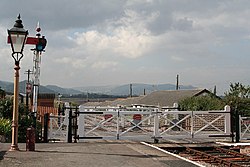Carhampton
| Carhampton | |
| Somerset | |
|---|---|
 St John the Baptist, Carhampton | |
| Location | |
| Grid reference: | ST005425 |
| Location: | 51°10’23"N, 3°25’29"W |
| Data | |
| Population: | 865 (2011) |
| Post town: | Minehead |
| Postcode: | TA24 |
| Dialling code: | 01643 |
| Local Government | |
| Council: | Somerset West and Taunton |
| Parliamentary constituency: |
Tiverton and Minehead |
Carhampton is a village in Somerset, four miles to the east of Minehead. The parish stretches from the Bristol Channel coast inland to Exmoor and has a population of 865 at the 2011 census.
The village gives its name to the county's Carhampton Hundred.

History
Iron Age occupation of the parish is evident from the remains of Bat's Castle hillfort and associated earthworks.[1] Archaeological excavation in the mid-1990s suggested the existence of early Christian settlement and burial to the east of the village, which had previously been the site of a metalworking settlement.[2]
Carhampton is thought to have been the centre for a Saxon royal estate. The king and his court would locate temporarily to Carhampton as part of a visiting circuit. One function was that officials of the royal court operated from Carhampton to collect taxes from surrounding estates. The village was subjected to Viking raids.
The Anglo-Saxon Chronicle state that, in 836, King Egbert fought the crews of 35 ships at Carhampton.[1] With the Danes in possession of the battlefield, the Chronicle recount a great slaughter.
Church
The parish Church of St John the Baptist dates from the Perpendicular period, but was extensively restored, and the north wall rebuilt in 1862–63. The tower was rebuilt between 1868 and 1870 and the vestry was added. It is a Grade I listed building.[3]
Legend
Carhampton is associated with the Arthurian legend of Saint Carantoc. Carantoc is said to have tamed a dragon,[1] or slain a serpent that was terrorising the inhabitants of Carrum (Carhampton). On victory, Carantoc was granted by Arthur the right to build a monastery in the village.
Wassailing
Carhampton is known for its wassailing celebration which was started in 1930s by the Taunton Cider Company. Wassailing in Carhampton takes place on 17 January in the orchard of the Butcher's Arms pub. This is preceded by a smaller event in the Community Orchard in the centre of the village next to the pub. The villagers form a circle around the largest apple tree, hang pieces of toast soaked in cider in the branches for the robin, who represent the 'good spirits' of the tree. A shotgun is fired overhead to scare away evil spirits.[4]
- Carhampton Wassailing Song
Old apple tree, we wassail thee,
And hoping thou wilt bear
For the Lord doth know where we shall be
Till apples come another year.
For to bear well, and to bear well
So merry let us be,
Let every man take off his hat,
And shout to the old apple tree!
Old apple tree, we wassail thee,
And hoping thou wilt bear
Hatfuls, capfuls and three bushel bagfuls
And a little heap under the stairs,
Hip, Hip, Hooray!
Outside links
| ("Wikimedia Commons" has material about Carhampton) |
References
- ↑ 1.0 1.1 1.2 Bush, Robin (1994). Somerset: The complete guide. Wimborne, Dorset: Dovecote Press. pp. 55–56. ISBN 1-874336-26-1. https://archive.org/details/somersetcomplete0000bush/page/55.
- ↑ National Heritage List 1013589: Early Christian to mediæval settlement and cemetery (Scheduled ancient monument entry)
- ↑ National Heritage List 1345731: Church of St John the Baptist (Grade I listing)
- ↑ Christian, Roy (1972). Old English Customs. David & Charles. pp. 113. ISBN 0-7153-5741-7.